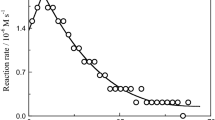Abstract
The kinetics of the aqua ligand substitution from hydroxopentaaquarhodium(III) ion, [Rh(H2O)5(OH)]2+, by l-Arginine has been studied spectrophotometrically as a function of Arginine concentration, and temperature, at pH 4.3. The reaction proceeds via a rapid outer sphere association complex formation step followed by two consecutive steps. The first of these involves ligand-assisted anation, while the second involves chelation as the second aqua ligand is displaced. The association equilibrium constant for the outer sphere complex formation has been evaluated together with the rate constants for the two subsequent steps. The activation parameters for both steps have been evaluated using Eyring’s equation. Thermodynamic parameters calculated from the temperature dependence of the outer sphere association equilibrium constants are also consistent with an associative mode of activation. The product of the reaction has been characterized by conductivity measurement and IR spectroscopic analysis.










Similar content being viewed by others
References
Rosenberg B, Vancamp L, Trosko JE, Mansour VH (1969) Nature (London) 222:385
Umapathy P (1989) Coord Chem Rev 95:129
Clarke MJ (1980) In: Martell AE (ed) Inorganic chemistry in biology and medicine, ACS Symposium on Ser 140. American Chemical Society, Washington DC p. 157 and references cited therein
Pruchink FP, Bien M, Lachowicz T (1996) Met Bas Drugs 3:185
Clarke MJ (1980) Met Ions Biol Syst 11:231
Yasbin RE, Matthews CR, Clarke MJ (1980) Chem Biol Interact 31:355
Cleare MJ, Hydes PC (1980) In: Siegel H (ed) Metal ions in biological systems, vol 2. Marcel Dekker, New York, pp 1–62
Monti-Bragadi C, Ramani L, Samer L, Mestroni G, Zassinovich G (1975) Antimicrob Agents Chemother 825
Mestroni G, Alessio GZ, Bontempi A (1987) Inorg Chim Acta 63:138
Katsaros N, Anagnostopoulou A (2002) Crit Rev Oncol Heamatol 42:297
Metal in Medicine (2007) J Biol Inorg Chem 12(Suppl 1):S7
Kostova I (2006) Recent patents on anticancer drug discovery 1:1
Kostova I (2006) Curr Med Chem 13:1085 and references therein
Pruchnik FP, Jakimowicz P, Cuinik Z, Zakrzewskaczerwinska J, Opolski A, Weitrzyk J, Wojdat E (2002) Inorg Chim Acta 334:59
Gil ED, Serrano SHP, Ferreira EI, Kubota LT (2002) J Pharm Biomed Anal 29:579
Tapiero H (2002) l-Arginine. Biomed Pharmacother 56:439
Stechmiller JK (2005) Arginine supplementation and wound healing. Nutr Clin Practice 20:52
Witte MB, Barbul A (2003) Arginine physiology and its implication for wound healing. Wound Repair Regenerat 11:419
Ayres GH, Forrester JS (1957) J Inorg Nucl Chem 3:365
Wolsey WC, Reynolds CA, Kleinberg J (1963) Inorg Chem 2:463
Pneumatikakis G, Hadjiliadis N (1979) J Inorg Nucl Chem 41:429
Steel D, Verhoeven PFM (2001) Vib Spectrosc 25:29
Martell AE, Smith RM (1974) Critical stability constants, vol I: Amino acids. Plenum Press, New York, p 43
Banyai I, Glaser J, Read MC, Sand Stroem M (1995) Inorg Chem 34:2423
Weyh JA, Hamm RE (1969) Inorg Chem 8:2298
Jeffrey GA (1997) An introduction to hydrogen bonding. Oxford University Press, Oxford
Desiraju GR, Steiner T (1999) The weak hydrogen bonding in structural chemistry and biology. Oxford University Press, Oxford
Author information
Authors and Affiliations
Corresponding author
Rights and permissions
About this article
Cite this article
Bera, B.K., Mallick, S., Mandal, A. et al. Kinetics and mechanism of the reaction of hydroxopentaaquarhodium(III) ion with l-Arginine in aqueous solution. Transition Met Chem 35, 541–547 (2010). https://doi.org/10.1007/s11243-010-9361-2
Received:
Accepted:
Published:
Issue Date:
DOI: https://doi.org/10.1007/s11243-010-9361-2




